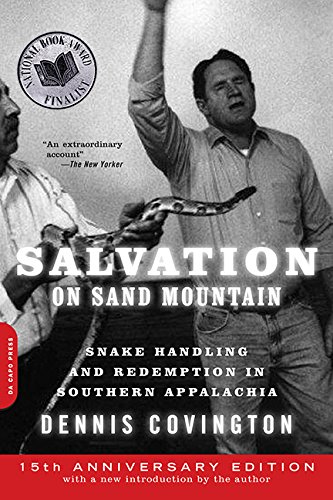 Salvation on Sand Mountain: Snake Handling and Redemption in Southern Appalachia by Dennis Covington.
Salvation on Sand Mountain: Snake Handling and Redemption in Southern Appalachia by Dennis Covington.
Does a journalist need to participate in his subject’s life and culture in order to write with insight and understanding about those subjects? For instance does one have to handle snakes in order to write about snake handlers, Pentecostal Christians who believe that they are showing the world their faith in Christ when they drink poison and handle snakes, taking their cue from Christ’s words?
“And these signs shall follow them that believe: In my name shall they cast out devils; they shall speak with new tongues. They will pick up serpents with their hands; and if they drink any deadly poison, it will not hurt them; they will lay their hands on the sick, and they will recover.†Mark 16:17-18
Behold, I give unto you power to tread on serpents and scorpions, and over all the power of the enemy: and nothing shall by any means hurt you. Luke 10:19
Or is a journalist who participates in such rituals not only a little crazy, but also devoid of journalistic objectivity? I would say the latter, but this book did make me think. It didn’t make me want to handle snakes, nor did it convince me that those who do so are anything other than thrill-seeking cultists. (There are other issues with the Jesus-only, legalistic, spiritual gift-seeking doctrine and practice of these snake handling churches.) What it did make me think about is the lines we draw between emotion and spiritual experience and reason, the way try to keep ourselves so safe that we wall out the Holy Spirit himself and become bored with our safe, unemotional, non-experiential Christianity. There’s a balance somewhere, and even though I see the kind of presumptuous testing of God that the snake handlers do as dangerous and somewhat prideful, I also see that we lose something precious when we say that God cannot and will not ever perform the kinds of miracles and signs that were common in the New Testament.
This book is about more than just snakes. The author reaches back into his own past and into his family heritage to try to understand just where the snake-handling preachers and testifiers have come from and what they really are experiencing when they “handle”. Mr. Covington also muses on the essence of a good story and how the ending is surprising but somehow inevitable. The book would fascinate fans of Flannery O’Connor’s stories, and in fact Covington begins his story with a quote from O’Connor:
“The descent into himself will, at the same time, be a descent into his region. It will be a descent through the darkness of the familiar into a world where, like the blind man cried in the gospels, he sees men as if they were trees, but walking.” ~Flannery O’Connor, Mystery and Manners.
Covington descends deep into himself and his region to try to explain the lives and actions of the people he comes to know and care for, such as:
Preacher Glendel Buford Summerford, accused of attempted murder of his wife by snakebite.
Darlene Summerford, the alleged victim, who keeps a photograph of her favorite snake in her purse.
Charles McGlocklin, end-time evangelist and snake handler.
Aline McGlocklin, his wife, also moved by the Spirit to handle on occasion.
Punkin Brown, legendary evangelist who would wipe the sweat off his brow with rattlesnakes.
Aunt Daisy, the prophetess.
Anna Pelfrey, who is said to have died twice and been revived by prayer.
Diane Pelfrey, her daughter, age 21 and a third-generation handler.
And others. Mr. Covington doesn’t make fun of these people and their beliefs, but rather he becomes a part of them, to an extent. Yet, it is the reservations he holds, the core of sanity and even dedication to something higher than mere ecstatic experience, that brings about an ending to the story of Dennis Covington and the snake handlers. It’s a good story and a good ending, and I learned something from the journey, although I’m not sure I can put it into words. If any of this rambling interests you, read the book. Then, come tell me what you learned.
Note: This book was published in 1995. Wikipedia says, “In 1998, snake-handling evangelist John Wayne “Punkin” Brown died after being bitten by a timber rattlesnake at the Rock House Holiness Church in rural northeastern Alabama.”
This one has been on my radar forever. In fact, it was one of the choices for books I could’ve taught in the community college freshman comp class I used to teach. Someday I’ll get to it. Have you read any of Rick Bragg’s books? They’re set in the same region, though they’re not about snake handlers.